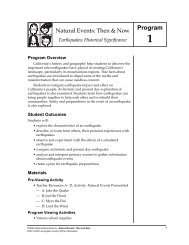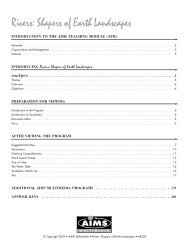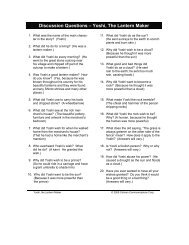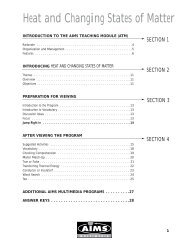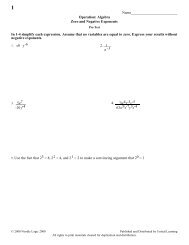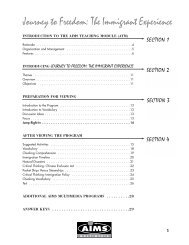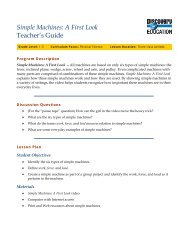Interactions in the Sun-Earth-Moon System - Discovery Education
Interactions in the Sun-Earth-Moon System - Discovery Education
Interactions in the Sun-Earth-Moon System - Discovery Education
Create successful ePaper yourself
Turn your PDF publications into a flip-book with our unique Google optimized e-Paper software.
<strong>Interactions</strong> <strong>in</strong> <strong>the</strong> <strong>Sun</strong>-<strong>Earth</strong>-<strong>Moon</strong> <strong>System</strong>Joey and his sister are on vacation <strong>in</strong> Turkey. Theyare very excited because on this sunny day <strong>the</strong>ywill get to see a total eclipse of <strong>the</strong> sun. Theirfriends back home will not be able to see any of it.Joey has made special glasses for everyone to useto safely observe <strong>the</strong> eclipse.He expla<strong>in</strong>s to his sister, “In just about an hour, <strong>the</strong> moon will pass <strong>in</strong> front of <strong>the</strong> sunand completely block it out! It will get very dark, like at sunset, and <strong>the</strong>n we’ll seesometh<strong>in</strong>g really special!”His sister looks up <strong>in</strong>to <strong>the</strong> sky and is very puzzled. She can see <strong>the</strong> sun, but <strong>the</strong> moonis nowhere <strong>in</strong> sight.How can an eclipse happen if <strong>the</strong> moon doesn’t seem to be <strong>the</strong>re?Why will <strong>the</strong>y have to wear <strong>the</strong>se special glasses if it will be dark dur<strong>in</strong>g <strong>the</strong> eclipse?What is <strong>the</strong> “someth<strong>in</strong>g special” that <strong>the</strong>y will see dur<strong>in</strong>g <strong>the</strong> eclipse?How can it be that <strong>the</strong>y will be able to see <strong>the</strong> eclipse, but none of <strong>the</strong>ir friends backhome <strong>in</strong> <strong>the</strong> United States can see it?Background InformationThe sun is <strong>the</strong> center of <strong>the</strong> solar system. All of <strong>the</strong> planets and planetary objects orbit aroundit. It takes <strong>the</strong> <strong>Earth</strong> 365 days or one year to orbit around <strong>the</strong> sun. While <strong>the</strong> <strong>Earth</strong> is orbit<strong>in</strong>garound <strong>the</strong> sun it is sp<strong>in</strong>n<strong>in</strong>g on its tilted axis. It takes 24 hours or one day for <strong>the</strong> <strong>Earth</strong> tocomplete one rotation on its axis.The moon is a satellite of <strong>the</strong> <strong>Earth</strong> and takes 28 days to orbit <strong>the</strong> <strong>Earth</strong>. It is much smaller than<strong>the</strong> <strong>Earth</strong> and is <strong>the</strong> closest object <strong>in</strong> space to <strong>the</strong> <strong>Earth</strong>. The moon does not produce its ownlight. It reflects light from <strong>the</strong> sun. The phases of <strong>the</strong> moon are dependent on where <strong>the</strong> moonis <strong>in</strong> its orbit around <strong>the</strong> <strong>Earth</strong>. When <strong>the</strong> moon appears to become fuller as <strong>the</strong> days go by <strong>the</strong>n<strong>the</strong> moon is a wax<strong>in</strong>g moon. As days go by and <strong>the</strong> moon appears to become a crescent shapeit is called a wan<strong>in</strong>g moon. The Lunar cycle ranges from <strong>the</strong> new moon where a moon is notvisible <strong>in</strong> <strong>the</strong> sky to a full moon where <strong>the</strong> moon seems fully illum<strong>in</strong>ated. The same side of <strong>the</strong>moon always faces <strong>the</strong> <strong>Earth</strong> and people are not able to see <strong>the</strong> o<strong>the</strong>r side of <strong>the</strong> moon from<strong>Earth</strong>.<strong>Discovery</strong> <strong>Education</strong> 2006. All Rights Reserved. page 1
A solar eclipse occurs when <strong>the</strong> moon passes between <strong>the</strong> <strong>Earth</strong> and <strong>the</strong> sun. This is alwaysdur<strong>in</strong>g a new moon. The moon can’t be seen because its lighted side is fac<strong>in</strong>g away from <strong>the</strong><strong>Earth</strong>, toward <strong>the</strong> sun it is about to pass <strong>in</strong> front of. Due to <strong>the</strong> distance and shape of <strong>the</strong> moon<strong>the</strong>re are times when it completely covers <strong>the</strong> sun dur<strong>in</strong>g an eclipse. Because of <strong>the</strong> tim<strong>in</strong>g of<strong>the</strong> <strong>Earth</strong>’s rotation and <strong>the</strong> lunar revolution, eclipses are seen at different po<strong>in</strong>ts on <strong>the</strong> <strong>Earth</strong>’ssurface. The size of <strong>the</strong> moon’s umbral shadow (where <strong>the</strong> sun appears to be completelyblocked) is relatively small about 100 miles wide. In addition, <strong>the</strong> moon’s orbit is not exactly <strong>in</strong>l<strong>in</strong>e with <strong>the</strong> <strong>Earth</strong>’s. This means that <strong>in</strong> many months no eclipse is visible anywhere on <strong>Earth</strong>.All this means that view<strong>in</strong>g a solar eclipse is a rare th<strong>in</strong>g. Dur<strong>in</strong>g a total solar eclipse, <strong>the</strong> moonblocks out all parts of <strong>the</strong> sun except its glow<strong>in</strong>g atmosphere. This is known as <strong>the</strong> corona.When this happens, people describe it as a r<strong>in</strong>g of fire around <strong>the</strong> moon with “diamond sparkles”where <strong>the</strong> sun’s light peeks through <strong>the</strong> mounta<strong>in</strong> gaps on <strong>the</strong> edge of <strong>the</strong> moon.When observ<strong>in</strong>g a solar eclipse it is important to protect <strong>the</strong> eyes. On a normal day it is toodifficult to look directly at <strong>the</strong> sun because it hurts and damages <strong>the</strong> ret<strong>in</strong>as of <strong>the</strong> eyes. Dur<strong>in</strong>g<strong>the</strong> total eclipse, people are tempted to look at <strong>the</strong> sun because <strong>the</strong> moon is block<strong>in</strong>g most of<strong>the</strong> light. The problem is <strong>in</strong> know<strong>in</strong>g when <strong>the</strong> moon’s edge will slip past <strong>the</strong> sun and <strong>the</strong>harmful light will return. Doctors recommend us<strong>in</strong>g special smoked lens glasses – sunglassesdo not provide nearly enough protection. Ano<strong>the</strong>r safe way to view <strong>the</strong> eclipse is with a p<strong>in</strong>-holecard. With <strong>the</strong> sun at your back, hold <strong>the</strong> card out and focus <strong>the</strong> light of <strong>the</strong> sun through <strong>the</strong> p<strong>in</strong>holeonto ano<strong>the</strong>r surface. The entire eclipse can be viewed this way and it’s easier to takepictures of <strong>the</strong> image.Of course, <strong>the</strong> <strong>Earth</strong> can come between <strong>the</strong> sun and <strong>the</strong> moon as well. This is called a lunareclipse. These always occur dur<strong>in</strong>g a full moon, when <strong>the</strong> moon is on <strong>the</strong> opposite side of <strong>Earth</strong>from <strong>the</strong> sun and all of <strong>the</strong> visible lunar surface is reflect<strong>in</strong>g light back to <strong>the</strong> <strong>Earth</strong>. <strong>Earth</strong>’sshadow passes completely across <strong>the</strong> whole moon (total lunar eclipse) or, more often, passesacross part of <strong>the</strong> moon (partial lunar eclipse). Aga<strong>in</strong>, <strong>the</strong> difference <strong>in</strong> <strong>the</strong> angle of <strong>the</strong> orbits of<strong>the</strong> moon and <strong>the</strong> <strong>Earth</strong> determ<strong>in</strong>e when a lunar eclipse will be full or partial. In a total lunareclipse, <strong>the</strong> moon turns a dull orange-redThe moon’s and sun’s gravity also has an <strong>in</strong>fluence on <strong>the</strong> <strong>Earth</strong>’s tides. The moon has astronger tidal force and is responsible for low and high tides <strong>in</strong> <strong>the</strong> ocean depend<strong>in</strong>g on where<strong>the</strong> moon is <strong>in</strong> <strong>the</strong> sky. The moon, because it is closer, has a greater effect on <strong>the</strong> tides, eventhough <strong>the</strong> sun is much larger. Gravitational force decreases exponentially with distance. Still,when both <strong>the</strong> sun and <strong>the</strong> moon are on <strong>the</strong> same side of <strong>Earth</strong> (dur<strong>in</strong>g a new moon phase) <strong>the</strong>gravitational force is strongest and <strong>the</strong> tide changes are much greater.F<strong>in</strong>ally, <strong>the</strong> tilt of <strong>the</strong> <strong>Earth</strong>’s axis is responsible for seasons. This is a very difficult concept forstudents to grasp and requires a lot of explanation and exploration. Simply put, <strong>the</strong> <strong>Earth</strong>’s axispo<strong>in</strong>ts <strong>in</strong> <strong>the</strong> same direction, toward <strong>the</strong> North Star, as it revolves around <strong>the</strong> sun. This means<strong>Discovery</strong> <strong>Education</strong> 2006. All Rights Reserved. page 2
that dur<strong>in</strong>g one part of it’s orbit, <strong>the</strong> nor<strong>the</strong>rn hemisphere is more exposed to <strong>the</strong> sun (be<strong>in</strong>gcloser does not have a noticeable effect). This hemisphere receives more direct sunlight, andwarms up accord<strong>in</strong>gly. At <strong>the</strong> same time, <strong>the</strong> sou<strong>the</strong>rn hemisphere gets less sunlight (it’s polegets none for a while). So <strong>the</strong> sou<strong>the</strong>rn hemisphere rema<strong>in</strong>s cooler. The <strong>Earth</strong> progresses <strong>in</strong>its orbit to <strong>the</strong> opposite side of <strong>the</strong> sun, with <strong>Earth</strong>s’ axis still po<strong>in</strong>t<strong>in</strong>g <strong>in</strong> <strong>the</strong> same direction. Now<strong>the</strong> sou<strong>the</strong>rn hemisphere receives more direct sunlight and warms up while <strong>the</strong> nor<strong>the</strong>rnhemisphere is gett<strong>in</strong>g less sunlight and cools down.Inquiry Problem SolutionWhile Joey’s sister cannot see <strong>the</strong> moon, it is <strong>the</strong>re near <strong>the</strong> sun <strong>in</strong> <strong>the</strong> sky. The moon does notreflect light to <strong>the</strong> <strong>Earth</strong> dur<strong>in</strong>g a solar eclipse because <strong>the</strong> sun is fur<strong>the</strong>r away, on <strong>the</strong> o<strong>the</strong>r sideof <strong>the</strong> moon. Only <strong>the</strong> moon’s dark side is fac<strong>in</strong>g <strong>the</strong> <strong>Earth</strong> just before it crosses <strong>the</strong> sun.When observ<strong>in</strong>g a solar eclipse it is important to protect your eyes. On a normal day it is toodifficult to look directly at <strong>the</strong> sun as it hurts and damages <strong>the</strong> eyes. It seems much easier tolook at <strong>the</strong> sun dur<strong>in</strong>g a solar eclipse because <strong>the</strong> moon is block<strong>in</strong>g most of <strong>the</strong> light. Butpeople should always where protective eye ware when look<strong>in</strong>g at eclipses. Ano<strong>the</strong>r way tosafely look at an eclipse is with a p<strong>in</strong>-hole camera. The image of <strong>the</strong> sun is projected ontoano<strong>the</strong>r surface and is not as bright, but just as clear.There is also “someth<strong>in</strong>g special” that <strong>the</strong>y will see. Dur<strong>in</strong>g a total solar eclipse, <strong>the</strong> moonblocks out all parts of <strong>the</strong> sun except its glow<strong>in</strong>g atmosphere. This is known as <strong>the</strong> sun’scorona. When this happens, people describe it as a r<strong>in</strong>g of fire around <strong>the</strong> moon with “diamondsparkles” where <strong>the</strong> corona’s light peeks between <strong>the</strong> mounta<strong>in</strong>s on <strong>the</strong> edge of <strong>the</strong> moon.Solar eclipses are very rare. It is not unusual to wait for twenty or thirty years to see one. Eventhough <strong>the</strong>y occur at least once a year, <strong>the</strong>y can only be seen from a small portion of <strong>the</strong> <strong>Earth</strong>’ssurface, usually a path about 100 miles wide and a thousand miles long, about <strong>the</strong> area of a th<strong>in</strong>strip of paper placed on a globe. In addition, Turkey is on <strong>the</strong> o<strong>the</strong>r side of <strong>the</strong> planet from us,so people <strong>in</strong> <strong>the</strong> United States would not likely be see<strong>in</strong>g <strong>the</strong> sun at that time – it would be night.<strong>Discovery</strong> <strong>Education</strong> 2006. All Rights Reserved. page 3



